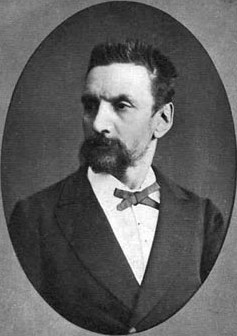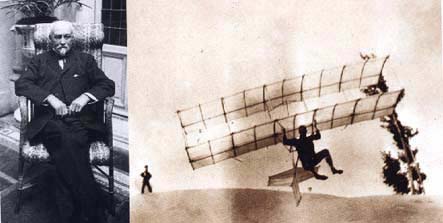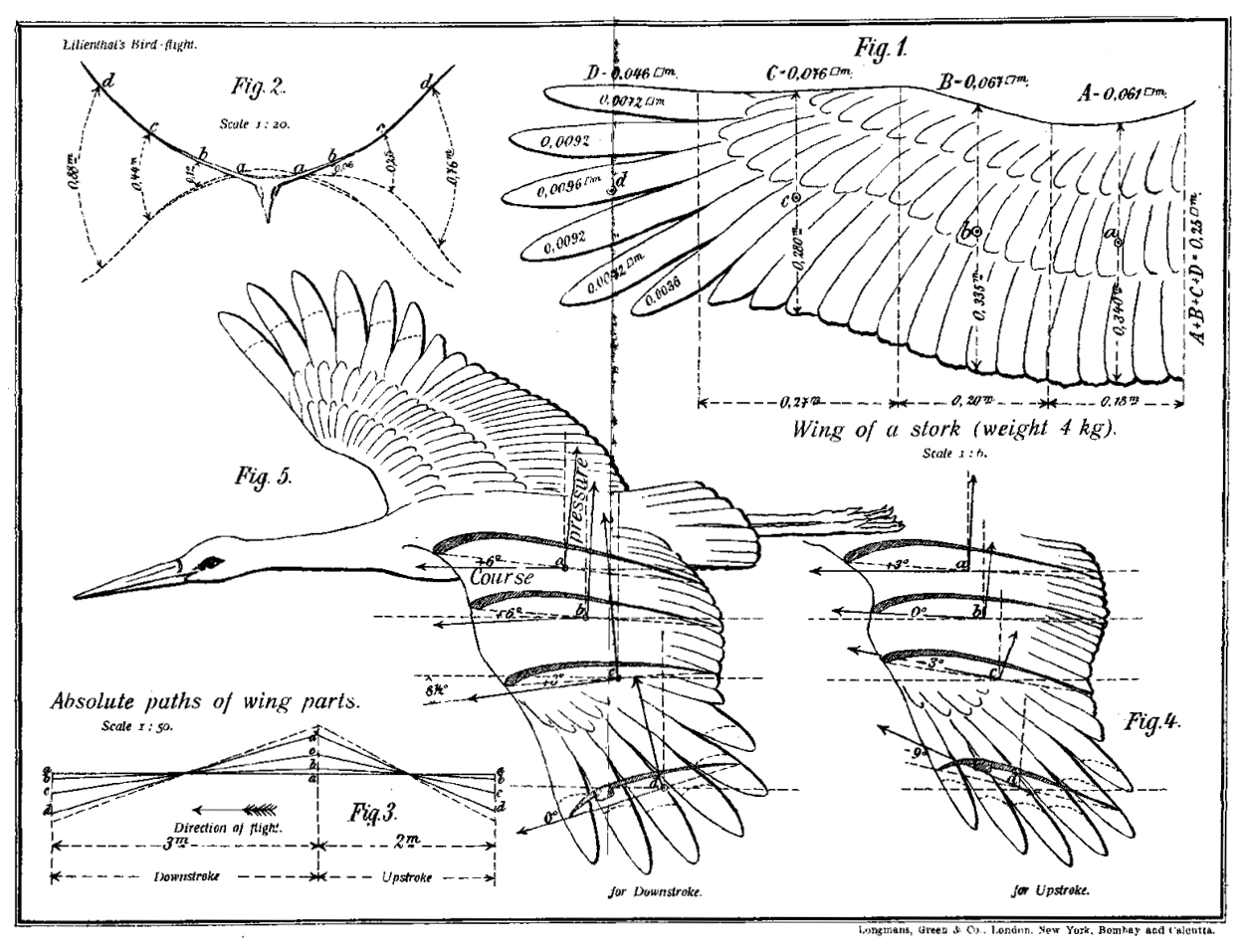|
Louis P. Mouillard
Louis Pierre Mouillard (September 30, 1834 – September 20, 1897) was a French artist and innovator who worked on human mechanical flight in the second half of the 19th century. He based much of his work on the investigation of birds in Algeria and Cairo. Around the early 1900s he was considered the ''father of aviation''. Mouillard's most famous work, ''L'Empire de l'Air'', in which he proposed fixed-wing gliders, was published in France in 1881 and soon became a widely recognized classic. It was translated into English by the Smithsonian Institution in theiannual report of 1892and reprinted in 1893 as ''The Empire Of The Air''. Mouillard studied at the School of Fine Arts at Lyon and Paris but settled in Algeria at Mitidja after the death of his father. Here he constructed several gliders before returning to France in 1865. Around this time he managed to glide 138 feet at about 30 feet height. He also described the use of a screw to provide lift and propulsion to a glider in ... [...More Info...] [...Related Items...] OR: [Wikipedia] [Google] [Baidu] |
Louis Mouillard , names sometimes translated to English as "Louis"
{{disambiguation ...
Louis may refer to: * Louis (coin) * Louis (given name), origin and several individuals with this name * Louis (surname) * Louis (singer), Serbian singer * HMS ''Louis'', two ships of the Royal Navy See also Derived or associated terms * Lewis (other) * Louie (other) * Luis (other) * Louise (other) * Louisville (other) * Louis Cruise Lines * Louis dressing, for salad * Louis Quinze, design style Associated names * * Chlodwig, the origin of the name Ludwig, which is translated to English as "Louis" * Ladislav and László - names sometimes erroneously associated with "Louis" * Ludovic, Ludwig, Ludwick, Ludwik Ludwik () is a Polish given name. Notable people with the name include: * Ludwik Czyżewski, Polish WWII general * Ludwik Fleck (1896–1961), Polish medical doctor and biologist * Ludwik Gintel (1899–1973), Polish-Israeli Olympic soccer play ... [...More Info...] [...Related Items...] OR: [Wikipedia] [Google] [Baidu] |
Cairo
Cairo ( ; ar, القاهرة, al-Qāhirah, ) is the capital of Egypt and its largest city, home to 10 million people. It is also part of the largest urban agglomeration in Africa, the Arab world and the Middle East: The Greater Cairo metropolitan area, with a population of 21.9 million, is the 12th-largest in the world by population. Cairo is associated with ancient Egypt, as the Giza pyramid complex and the ancient cities of Memphis and Heliopolis are located in its geographical area. Located near the Nile Delta, the city first developed as Fustat, a settlement founded after the Muslim conquest of Egypt in 640 next to an existing ancient Roman fortress, Babylon. Under the Fatimid dynasty a new city, ''al-Qāhirah'', was founded nearby in 969. It later superseded Fustat as the main urban centre during the Ayyubid and Mamluk periods (12th–16th centuries). Cairo has long been a centre of the region's political and cultural life, and is titled "the city of a thousa ... [...More Info...] [...Related Items...] OR: [Wikipedia] [Google] [Baidu] |
Mouillard Book
Louis Pierre Mouillard (September 30, 1834 – September 20, 1897) was a French artist and innovator who worked on human mechanical flight in the second half of the 19th century. He based much of his work on the investigation of birds in Algeria and Cairo. Around the early 1900s he was considered the ''father of aviation''. Mouillard's most famous work, ''L'Empire de l'Air'', in which he proposed fixed-wing gliders, was published in France in 1881 and soon became a widely recognized classic. It was translated into English by the Smithsonian Institution in theiannual report of 1892and reprinted in 1893 as ''The Empire Of The Air''. Mouillard studied at the School of Fine Arts at Lyon and Paris but settled in Algeria at Mitidja after the death of his father. Here he constructed several gliders before returning to France in 1865. Around this time he managed to glide 138 feet at about 30 feet height. He also described the use of a screw to provide lift and propulsion to a glider in ... [...More Info...] [...Related Items...] OR: [Wikipedia] [Google] [Baidu] |
Lyon
Lyon,, ; Occitan: ''Lion'', hist. ''Lionés'' also spelled in English as Lyons, is the third-largest city and second-largest metropolitan area of France. It is located at the confluence of the rivers Rhône and Saône, to the northwest of the French Alps, southeast of Paris, north of Marseille, southwest of Geneva, northeast of Saint-Étienne. The City of Lyon proper had a population of 522,969 in 2019 within its small municipal territory of , but together with its suburbs and exurbs the Lyon metropolitan area had a population of 2,280,845 that same year, the second most populated in France. Lyon and 58 suburban municipalities have formed since 2015 the Lyon Metropolis, Metropolis of Lyon, a directly elected metropolitan authority now in charge of most urban issues, with a population of 1,411,571 in 2019. Lyon is the Prefectures in France, prefecture of the Auvergne-Rhône-Alpes Regions of France, region and seat of the Departmental council (France), Departmental Coun ... [...More Info...] [...Related Items...] OR: [Wikipedia] [Google] [Baidu] |
Octave Chanute
Octave Chanute (February 18, 1832 – November 23, 1910) was a French-American civil engineer and aviation pioneer. He provided many budding enthusiasts, including the Wright brothers, with help and advice, and helped to publicize their flying experiments. At his death he was hailed as the father of aviation and the initial concepts of the heavier-than-air flying machine. Biography Born in Paris, Chanute was the son of Elise and Joseph Chanut, professor at the Collège de France. He emigrated with his father to the United States of America in 1838, when the former was named Vice-President at Jefferson College in Louisiana. Octave attended private schools in New York. Civil engineer (railroads) Octave Chanute began his training as a budding civil engineer in 1848. He was widely considered brilliant and innovative in the engineering profession. During his career he designed and constructed the United States two biggest stockyards, Chicago Stock Yards (1865) and Kansas City ... [...More Info...] [...Related Items...] OR: [Wikipedia] [Google] [Baidu] |
Matthew Piers Watt Boulton
Matthew Piers Watt Boulton (22 September 1820 – 30 June 1894), also published under the pseudonym M. P. W. Bolton, was a British classicist, elected member of the UK's Metaphysical Society, an amateur scientist and an inventor, best known for his invention of the aileron, a primary aeronautical flight control device. He patented the aileron in 1868, some 36 years before it was first employed in manned flight by Robert Esnault-Pelterie in 1904. Boulton was the son of Matthew Robinson Boulton, and as well the grandson of Matthew Boulton, who founded the Soho Manufactory and the Soho Mint. His grandfather also co-founded the Soho Foundry with James Watt, which employed steam engines of the latter's design. Born into a family of significant wealth and means, M. P. W. was broadly educated in the classics, philosophy and sciences, subsequently becoming well versed in steam engine design, and then transferring his interest to the basic conceptual designs o ... [...More Info...] [...Related Items...] OR: [Wikipedia] [Google] [Baidu] |
Otto Lilienthal
Karl Wilhelm Otto Lilienthal (23 May 1848 – 10 August 1896) was a German pioneer of aviation who became known as the "flying man". He was the first person to make well-documented, repeated, successful flights with gliders, therefore making the idea of " heavier than air" a reality. Newspapers and magazines published photographs of Lilienthal gliding, favourably influencing public and scientific opinion about the possibility of flying machines becoming practical. Lilienthal's work led to him developing the concept of the modern wing. His flight attempts in 1891 are seen as the beginning of human flight and the "Lilienthal Normalsegelapparat" is considered to be the first airplane in series production, making the ''Maschinenfabrik Otto Lilienthal'' the first air plane production company in the world. Otto Lilienthal is often referred to as either the "father of aviation" or "father of flight". On 9 August 1896, his glider stalled and he was unable to regain control. Falling ... [...More Info...] [...Related Items...] OR: [Wikipedia] [Google] [Baidu] |
List Of Early Flying Machines
Early flying machines include all forms of aircraft An aircraft is a vehicle that is able to fly by gaining support from the air. It counters the force of gravity by using either static lift or by using the dynamic lift of an airfoil, or in a few cases the downward thrust from jet engines. ... studied or constructed before the development of the modern aeroplane by 1910. The story of modern flight begins more than a century before the first successful manned aeroplane, and the earliest aircraft thousands of years before. Primitive beginnings Legends Some ancient mythologies feature legends of men using flying devices. One of the earliest known is the Greek mythology, Greek legend of Daedalus; in Ovid's version, Daedalus fastens feathers together with thread and wax to mimic the wings of a bird. Other ancient legends include the Hindu mythology, Indian Vimana flying palace or chariot, the biblical Merkabah mysticism, Ezekiel's Chariot, the Irish mythology, Irish ''r ... [...More Info...] [...Related Items...] OR: [Wikipedia] [Google] [Baidu] |
Aviation Pioneers
Aviation pioneers are people directly and indirectly responsible for the advancement of flight, including people who worked to achieve manned flight before the invention of aircraft, as well as others who achieved significant "firsts" in aviation after heavier-than-air flight became routine. Pioneers of aviation have contributed to the development of aeronautics in one or more ways: through science and theory, theoretical or applied design, by constructing models or experimental prototypes, the mass production of aircraft for commercial and government request, achievements in flight, and providing financial resources and publicity to expand the field of aviation. Table key Pioneer type * Science: Contributions to aerodynamic theory, aviation principles, discoveries advancing aircraft development, etc. * Design: Original or derivative ideas or drawings for conceptual/experimental/practical methods of air travel * Construction: Building prototypes/experimental/practical aircraft ... [...More Info...] [...Related Items...] OR: [Wikipedia] [Google] [Baidu] |
French Glider Pilots
French (french: français(e), link=no) may refer to: * Something of, from, or related to France ** French language, which originated in France, and its various dialects and accents ** French people, a nation and ethnic group identified with France ** French cuisine, cooking traditions and practices Fortnite French places Arts and media * The French (band), a British rock band * "French" (episode), a live-action episode of ''The Super Mario Bros. Super Show!'' * ''Française'' (film), 2008 * French Stewart (born 1964), American actor Other uses * French (surname), a surname (including a list of people with the name) * French (tunic), a particular type of military jacket or tunic used in the Russian Empire and Soviet Union * French's, an American brand of mustard condiment * French catheter scale, a unit of measurement of diameter * French Defence, a chess opening * French kiss, a type of kiss involving the tongue See also * France (other) * Franch, a surname * Frenc ... [...More Info...] [...Related Items...] OR: [Wikipedia] [Google] [Baidu] |
Aviation Inventors
Aviation includes the activities surrounding mechanical flight and the aircraft industry. ''Aircraft'' includes fixed-wing and rotary-wing types, morphable wings, wing-less lifting bodies, as well as lighter-than-air craft such as hot air balloons and airships. Aviation began in the 18th century with the development of the hot air balloon, an apparatus capable of atmospheric displacement through buoyancy. Some of the most significant advancements in aviation technology came with the controlled gliding flying of Otto Lilienthal in 1896; then a large step in significance came with the construction of the first powered airplane by the Wright brothers in the early 1900s. Since that time, aviation has been technologically revolutionized by the introduction of the jet which permitted a major form of transport throughout the world. Etymology The word ''aviation'' was coined by the French writer and former naval officer Gabriel La Landelle in 1863. He derived the term from the ... [...More Info...] [...Related Items...] OR: [Wikipedia] [Google] [Baidu] |
19th-century French Inventors
The 19th (nineteenth) century began on 1 January 1801 ( MDCCCI), and ended on 31 December 1900 ( MCM). The 19th century was the ninth century of the 2nd millennium. The 19th century was characterized by vast social upheaval. Slavery was abolished in much of Europe and the Americas. The First Industrial Revolution, though it began in the late 18th century, expanding beyond its British homeland for the first time during this century, particularly remaking the economies and societies of the Low Countries, the Rhineland, Northern Italy, and the Northeastern United States. A few decades later, the Second Industrial Revolution led to ever more massive urbanization and much higher levels of productivity, profit, and prosperity, a pattern that continued into the 20th century. The Islamic gunpowder empires fell into decline and European imperialism brought much of South Asia, Southeast Asia, and almost all of Africa under colonial rule. It was also marked by the collapse of the la ... [...More Info...] [...Related Items...] OR: [Wikipedia] [Google] [Baidu] |


.jpg)





